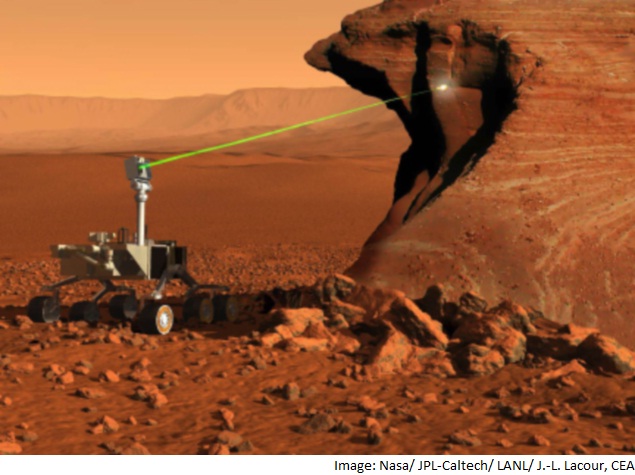- Home
- Science
- Science News
- Nasa's Curiosity Rover Finds Rocks Similar to Earth's Crust on Mars
Nasa's Curiosity Rover Finds Rocks Similar to Earth's Crust on Mars

The discovery comes amid growing evidence that, in the past, Mars may have been much more similar to the ancient Earth than scientists had thought.
The robotic exploratory vehicle has been moving through the area surrounding Gale Crater, which was formed about 3.6 billion years ago, and there it has discovered light-coloured, quartzlike rocks that contrast with the ones of basaltic composition it had encountered in geologically younger areas so far on its Martian trek.
The continental crust, which is less dense and of a different composition than that beneath the oceans, had been thought to be unique to Earth and had been attributed to the complex magmatic process possibly related to the appearance of our planet's tectonic plates.
In the case of the Martian crust, however, scientists had thought that there was never any magmatic process at work and, thus, the crust must have been formed mainly of basalt, although recent missions to Mars have discovered isolated examples of materials rich in silica, casting doubt on the basalt-only hypothesis.
An international team analysed the geochemical data from more than 22 rocks examined with Curiosity's ChemCam instrument - which uses a laser to zap rock samples and analyses the resulting vapour puff - while the small wheeled robot vehicle has been traversing an ancient landscape near Gale Crater.
The experts, headed by Violaine Sautter, with the French Museum of Natural History, found that the light rocks are rich in silica and are of different compositions.
The composition of some of those rocks is similar to some of the Earth's oldest continental crust materials.
The scientists suggest that the light rocks rich in silica could be the remains of an ancient Martian crust similar to Earth's first continental crust, although they said that more data is needed to be able to confirm that.
Catch the latest from the Consumer Electronics Show on Gadgets 360, at our CES 2026 hub.
Related Stories
- Samsung Galaxy Unpacked 2025
- ChatGPT
- Redmi Note 14 Pro+
- iPhone 16
- Apple Vision Pro
- Oneplus 12
- OnePlus Nord CE 3 Lite 5G
- iPhone 13
- Xiaomi 14 Pro
- Oppo Find N3
- Tecno Spark Go (2023)
- Realme V30
- Best Phones Under 25000
- Samsung Galaxy S24 Series
- Cryptocurrency
- iQoo 12
- Samsung Galaxy S24 Ultra
- Giottus
- Samsung Galaxy Z Flip 5
- Apple 'Scary Fast'
- Housefull 5
- GoPro Hero 12 Black Review
- Invincible Season 2
- JioGlass
- HD Ready TV
- Laptop Under 50000
- Smartwatch Under 10000
- Latest Mobile Phones
- Compare Phones
- Samsung Galaxy A07 5G
- Vivo Y500i
- OnePlus Turbo 6V
- OnePlus Turbo 6
- Itel Zeno 20 Max
- OPPO Reno 15 Pro Mini 5G
- Poco M8 Pro 5G
- Motorola Signature
- Lenovo Yoga Slim 7x (2025)
- Lenovo Yoga Slim 7a
- Realme Pad 3
- OPPO Pad Air 5
- NoiseFit Pro 6R
- Xiaomi Watch 5
- Acerpure Nitro Z Series 100-inch QLED TV
- Samsung 43 Inch LED Ultra HD (4K) Smart TV (UA43UE81AFULXL)
- Asus ROG Ally
- Nintendo Switch Lite
- Haier 1.6 Ton 5 Star Inverter Split AC (HSU19G-MZAID5BN-INV)
- Haier 1.6 Ton 5 Star Inverter Split AC (HSU19G-MZAIM5BN-INV)

















